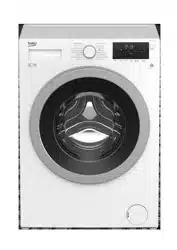Documents: Go to download!
User Manual
- Owner's manual - (English)
- WMY8046LB2 - Beko - Datasheet - (English)
- Intended use
- Technical specifications
- Troubleshooting
Table of contents
Intended use
- This product has been designed for domestic use. It is not for commercial purposes or it should not be used out of its intended use.
- The product must only be used for washing and rinsing of laundry that are marked accordingly.
- The manufacturer waives any responsibility arisen from incorrect usage or transportation.
Technical specifications
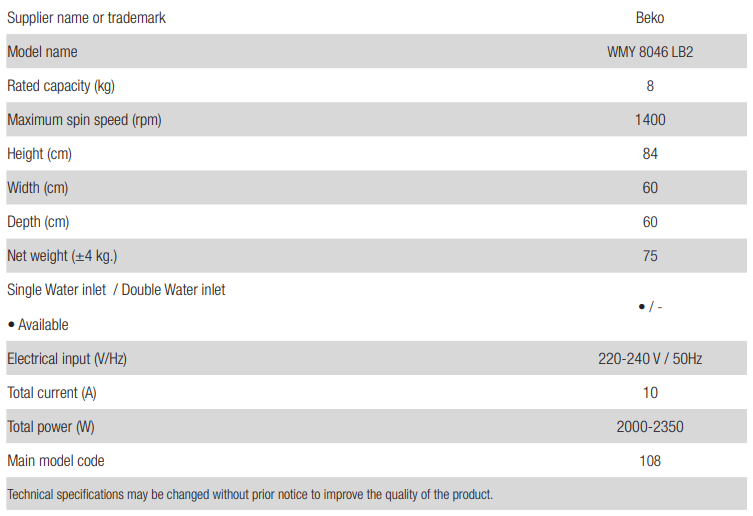
Installation
- Apply to the nearest authorized service agent for the installation of your product.
- Preparation of the location and electrical, tap water and waste water installations at the place of installation is under customer's responsibility.
- Make sure that the water inlet and discharge hoses as well as the power cable are not folded, pinched or crushed while pushing the product into its place after installation or cleaning procedures.
- Make sure that the installation and electrical connections of the product are performed by authorized service. Manufacturer shall not be held liable for damages that may arise from procedures carried out by unauthorized persons.
- Prior to installation, visually check if the product has any defects on it. If so, do not have it installed. Damaged products cause risks for your safety.
Appropriate installation location
- Place the product on a hard and level floor. Do not put it onto a carpet with high pile or other similar surfaces.
- When the washing machine and drier are placed on top of each other, their total weight –when loaded– amounts to 180 kilograms. Place the product on a solid and flat floor that has sufficient load carrying capacity!
- Do not place the product on the power cable.
- Do not install the product in the environments where the temperature falls below 0 ºC.
- Leave a minimum space of 1 cm between the machine and the furniture.
- On a graduated floor, do not place the product next to the edge or on a platform.
Removing packaging reinforcement
Tilt the machine backwards to remove the packaging reinforcement. Remove the packaging reinforcement by pulling the ribbon. Do not make this operation alone by yourself.
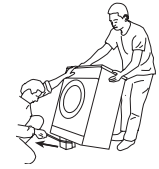
Removing the transportation locks
- Loose all bolts with an appropriate wrench until they turn freely (C).
- Remove the transport safety bolts by turning them slightly.
- Insert the plastic covers in the bag containing the user manual to the openings on the rear panel. (P)

CAUTION: Remove the transportation safety bolts before operating the washing machine! Otherwise, the product will be damaged.
Keep the transportation safety bolts in a safe place to reuse when the washing machine needs to be moved again in the future.
Install the transport safety bolts in reverse order of the disassembly procedure.
Never move the product without the transportation safety bolts properly fixed in place!
Connecting water supply
The water supply pressure required to run the product is between 1 to 10 bars (0.1 – 1 MPa). It is necessary to have 10 – 80 liters of water flowing from the fully open tap in one minute to have your machine run smoothly. Attach a pressure reducing valve if water pressure is higher.
If you are going to use the double water-inlet product as a single (cold) water-inlet unit, you must install the supplied stopper to the hot water valve before operating the product. (Applies for the products supplied with a blind stopper group.)
CAUTION: Models with a single water inlet should not be connected to the hot water tap. In such a case the laundry will get damaged or the product will switch to protection mode and will not operate.
CAUTION: Do not use old or used water inlet hoses on the new product. It may cause stains on your laundry.
Connect the special water supply hoses supplied with the product to the water inlets on the product. Red hose (left) (max. 90 ºC) is for hot water inlet, blue hose (right) (max. 25 ºC) is for cold water inlet.
Make sure that the hot and cold water taps are connected correctly when the product is being installed. Otherwise, your laundry will come out hot at the end of the washing process and wear out.
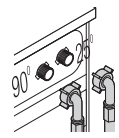
- Tighten the nuts of the hose by hand. Never use a tool when tightening the nuts.
- When hose connection is completed, check whether there is leak problems at the connection points by opening the taps fully. If any leaks occur, turn off the tap and remove the nut. Retighten the nut carefully after checking the seal. In order to prevent the water leaks and resultant damages, keep the taps closed when you do not use the product.
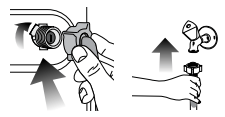
Connecting the drain hose to the drain
- Attach the end of the drain hose directly to waste water drain, lavatory or bathtub.
CAUTION: Your drain house will be flooded if the hose comes out of its housing during water discharge. Moreover, there is risk of scalding due to high washing temperatures! In order to prevent such situations and make sure that the machine performs water intake and discharge processes without any problem, fix the drain hose securely
- Connect the drain hose to a minimum height of 40 cm and a maximum height of 100 cm.
- In case the drain hose is elevated after laying it on the floor level or close to the ground (less than 40 cm above the ground), water discharge becomes more difficult and the laundry may come out excessively wet. Therefore, follow the heights described in the figure.
- To prevent the waste water to go back into the machine again and to ensure easy drainage, do not immerse the end of the hose into the waste water or do not insert it into the drain for more than 15 cm. If it is too long, cut it short.
- The end of the hose should not be bent, it should not be stepped on and the hose must not be pinched between the drain and the machine.
- If the length of the hose is too short, use it by adding an original extension hose. Length of the hose may not be longer than 3.2 m. To avoid water leak failures, the connection between the extension hose and the drain hose of the product must be fitted well with an appropriate clamp as not to come off and leak.
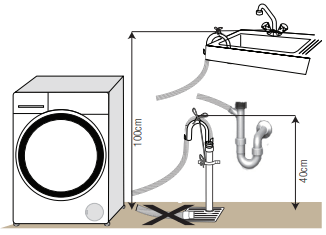
Adjusting the feet
CAUTION: In order to ensure that the product operates more silently and vibration-free, it must stand level and balanced on its feet. Balance the machine by adjusting the feet. Otherwise, the product may move from its place and cause crushing and vibration problems.
CAUTION: Do not use any tools to loosen the lock nuts. Otherwise, they will get damaged
- Loosen the lock nuts on the feet by hand.
- Adjust the feet until the product stands in a stable and balanced way.
- Tighten all lock nuts by hand again.

Electrical connection
Connect the product to a grounded outlet protected by a 16 A fuse. Our company shall not be liable for any damages that will arise when the product is used without grounding in accordance with the local regulations.
- Connection must comply with national regulations.
- Power cable plug must be within easy reach after installation.
- If the current value of the fuse or breaker in the house is less than 16 Amps, have a qualified electrician install a 16 Amp fuse.
- The voltage specified in the "Technical specifications" section must be equal to your mains voltage.
- Do not make connections via extension cables or multi-plugs.
CAUTION: Damaged power cables must be replaced by the Authorized Service Agents
Initial use
Before starting to use the product make sure that the preparations are made which are in line with the “Important Safety and Environment Instructions” and the instructions in the “Installation” section.
To prepare the product for washing laundry, perform first operation in Drum Cleaning programme. If this program is not available in your machine, apply the method which is described in the section 4.4.2.

Use an anti-limescale suitable for the washing machines.
Some water might have remained in the product due to the quality control processes in the production. It is not harmful for the product.
Preparation
Sorting the laundry
* Sort laundry according to type of fabric, color, and degree of soiling and allowable water temperature.
* Always obey the instructions given on the garment tags.
Preparing laundry for washing
- Laundry items with metal attachments such as, underwired bras, belt buckles or metal buttons will damage the machine. Remove the metal pieces or wash the clothes by putting them in a laundry bag or pillow case.
- Take out all substances in the pockets such as coins, pens and paper clips, and turn pockets inside out and brush. Such objects may damage the product or cause noise problem.
- Put small size clothes such as infant's socks and nylon stockings in a laundry bag or pillow case.
- Place curtains in without compressing them. Remove curtain attachment items.
- Fasten zippers, sew loose buttons and mend rips and tears.
- Wash “machine washable” or “hand washable” labeled products only with an appropriate programme.
- Do not wash colours and whites together. New, dark coloured cottons release a lot of dye. Wash them separately.
- Tough stains must be treated properly before washing. If unsure, check with a dry cleaner.
- Only use the dyes / color changers and descaling agents which are appropriate to machine wash. Always follow the instructions on the package.
- Wash trousers and delicate laundry turned inside out.
- Keep laundry items made of Angora wool in the freezer for a few hours before washing. This will reduce pilling.
- Laundry that are subjected to materials such as flour, lime dust, milk powder, etc. intensely must be shaken off before placing into the machine. Such dusts and powders on the laundry may build up on the inner parts of the machine in time and can cause damage.
Things to be done for energy saving
Following information will help you use the product in an ecological and energy-efficient manner.
- Operate the product in the highest capacity allowed by the programme you have selected, but do not overload; see, "Programme and consumption table". See, “Programme and consumption table"
- Always follow the instructions on the detergent packaging.
- Wash slightly soiled laundry at low temperatures.
- Use faster programmes for small quantities of lightly soiled laundry.
- Do not use prewash and high temperatures for laundry that is not heavily soiled or stained.
- If you plan to dry your laundry in a dryer, select the highest spin speed recommended during washing process.
- Do not use more detergent than the recommended amount specified on its package.
Loading the laundry
- Open the laundry cover.
- Put the laundry items into the machine in a loose manner.
- Push and close the loading cover until you hear the locking sound. Ensure that no items are caught in the door. The loading door is locked while a programme is running. The door can only be opened a while after the programme comes to an end.
Correct load capacity
The maximum load capacity depends on the type of laundry, the degree of soiling and the washing programme desired.
Machine automatically adjusts the water amount according to the weight of the laundry put inside it. A
WARNING: Follow the information in the “Programme and consumption table”. When overloaded, machine's washing performance will drop. Moreover, noise and vibration problems may occur.
Using detergent and softener
When using detergent, softener, starch, fabric dye, bleacher and decolorant, descaling agents; read the manufacturer's instructions written on the package and follow the dosages specified. Use measuring cup if available.
The detergent drawer is composed of three compartments:
– (1) for prewash
– (2) for main wash
– (3) for softener
– ( ) in addition, there is a siphon piece in the softener compartment.
) in addition, there is a siphon piece in the softener compartment.
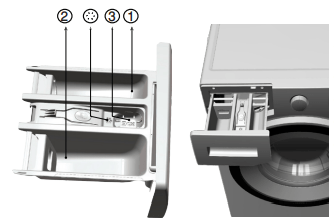
Detergent, softener and other cleaning agents
- Add detergent and softener before starting the washing programme.
- While the washing cycle is in progress, do not leave the detergent dispenser open!
- When using a programme without prewash, do not put any detergent into the prewash compartment (compartment nr. "1").
- In a programme with prewash, do not put liquid detergent into the prewash compartment (compartment nr. "1").
- Do not select a programme with prewash if you are using a detergent bag or dispensing ball. Place the detergent bag or the dispensing ball directly among the laundry in the machine.
If you are using liquid detergent, do not forget to place the liquid detergent container into the main wash compartment (compartment number “2”).
Choosing the detergent type
Detergent type to be used depends on the fabric type and color.
- Use different detergents for coloured and white laundry.
- Wash your delicate clothes only with special detergents (liquid detergent, wool shampoo, etc.) used solely for delicate clothes.
- When washing dark coloured clothes and quilts, it is recommended to use liquid detergent.
- Wash woolens with special detergent made specifically for woolens.
CAUTION: Use only detergents manufactured specifically for washing machines.
CAUTION: Do not use soap powder
Adjusting detergent amount
The amount of washing detergent to be used depends on the amount of laundry, the degree of soiling and water hardness.
- Do not use amounts exceeding the dosage quantities recommended on the detergent package to avoid problems of excessive foam, poor rinsing, financial savings and finally, environmental protection.
- Use lesser detergent for small amounts or lightly soiled clothes.
Using softeners
Pour the softener into the softener compartment of the detergent drawer.
- Do not exceed the (>max<) level sign on the softener compartment.
- If the softener has lost its fluidity, dilute it with water before putting it in the detergent drawer.
Using liquid detergents
If the product contains a liquid detergent cup:
- Put the liquid detergent container into the compartment no “2”.
- If the liquid detergent lost its fluidity, dilute it with water before putting it into the detergent container.

If the product does not contain a liquid detergent cup:
- Do not use liquid detergent for the prewash in a programme with prewash.
- Liquid detergent stains your clothes when used with Delayed Start function. If you are going to use the Delayed Start function, do not use liquid detergent.
Using gel and tablet detergent
- If the gel detergent thickness is fluidal and your machine does not contain a special liquid detergent cup, put the gel detergent into the main wash detergent compartment during first water intake. If your machine contains a liquid detergent cup, fill the detergent into this cup before starting the programme.
- If the gel detergent thickness is not fluidal or in the shape of capsule liquid tablet, put it directly into the drum before washing.
- Put tablet detergents into the main wash compartment (compartment nr. "2") or directly into the drum before washing.
Using starch
- Put the liquid soda, powder soda or the fabric dye into the softener compartment.
Do not use softener and starch together in a washing cycle.
Wipe the inside of the machine with a damp and clean cloth after using starch.
Using limescale remover
- When required, use limescale removers manufactured specifically for washing machines only.
Using bleaches
Add the bleach at the beginning of the washing cycle by selecting a prewash program. Do not put detergent in the prewash compartment. As an alternative application, select a programme with extra rinse and add the bleaching agent while the machine is taking water from the detergent compartment during first rinsing step.
- Do not use bleaching agent and detergent by mixing them.
- Use just a little amount (approx. 50 ml) of bleaching agent and rinse the clothes very well as it causes skin irritation. Do not pour the bleach onto the laundry and do not use it with the colored items.
- When using oxygen-based decolorant, select a program which washes the laundry at a low temperature.
- Oxygen-based decolorant can be used with the detergent; however, if it is not at the same consistence, first put detergent in the compartment number “2” in the detergent dispenser and wait for the machine to flush the detergent when taking in water. While the machine continues taking in water, add decolorant in the same compartment.
Tips for efficient washing
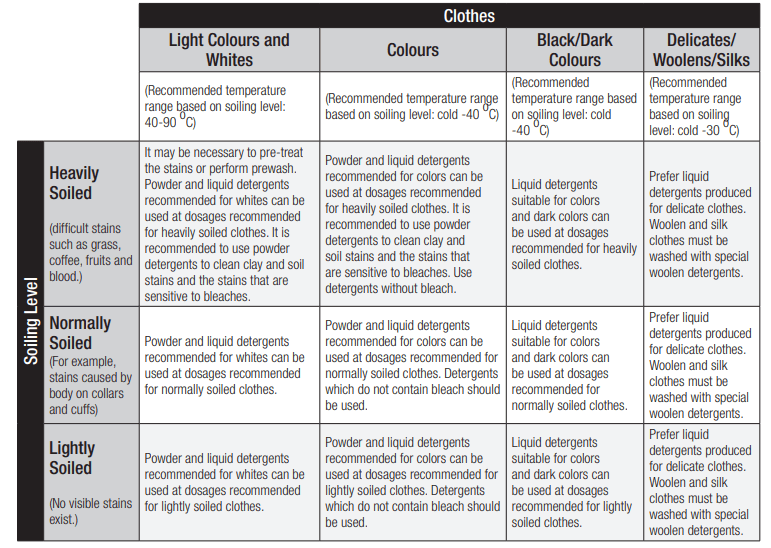
Operating the product
Control panel
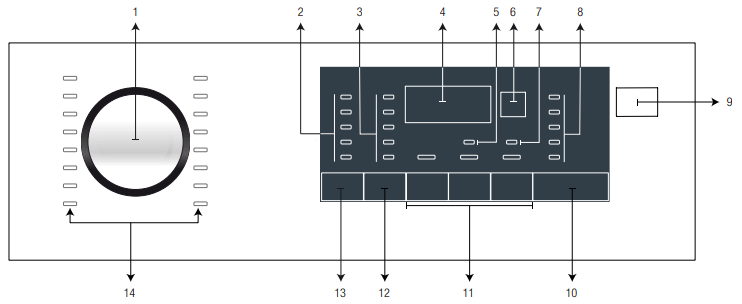
- - Programme selection knob
- - Temperature selection LEDs
- - Spin speed selection LEDs
- - Duration information display
- - Child lock enabled LED
- - End Time Setting button
- - Door lock enabled LED
- - Programme follow-up indicator LEDs
- - On / Off button
- - Start / Pause button
- - Auxiliary function buttons
- - Spin speed adjustment button
- - Temperature adjustment button
- - Programme Selection LEDs
Programme selection
1. Determine the programme suitable for the type, quantity and soiling level of the laundry in accordance with the "Programme and consumption table".
1. Select the desired programme with the “Programme Selection” knob.
Programmes are limited with the highest spin speed appropriate for that particular type of fabric.
When selecting the program you will use, always take fabric type, color, soil degree and permitted water temperature into consideration.
Always prefer the lowest temperature value which is fit to your laundry type. Higher temperature means higher power consumption.
Programmes
- Cottons
Use this programme for your durable whites and colourfast cotton clothes. This programme is suggested for washing heavily soiled items.
- Synthetics
Use to wash your synthetic clothes (shirts, blouses, synthetic/cotton blends, etc.). It washes with a gentle action and has a shorter washing cycle compared to the Cottons programme.
For curtains and tulle, use the Synthetic 40˚C programme with prewash and anti-creasing functions selected.
As their meshed texture causes excessive foaming, wash the veils/tulle by putting little amount of detergent into the main wash compartment. Do not put detergent in the prewash compartment.
- Wool
Use to wash your woolen clothes. Select the appropriate temperature complying with the tags of your clothes.
Use appropriate detergents for woolens.
“The wool wash cycle of this machine has been approved by The Woolmark Company for the washing of machine washable wool products provided that the products are washed according to the instructions on the garment label and those issued by the manufacturer of this washing machine. M14069.”
“In UK, Eire, Hong Kong and India the Woolmark trade mark is a Certification trade mark.”

- Cottons Eco
Use to wash your normally soiled, durable cotton and linen laundry. Although it washes longer than all other programmes, it provides high energy and water savings. Actual water temperature may be different from the stated wash temperature. When you load the machine with less laundry (e.g. ½ capacity or less), programme time may automatically get shorter. In this case, energy and water consumption will decrease more, providing a more economic wash. This programme is available in the models with the remaining time indicator.
- Anti-Allergy+
Use this programme for your laundry for which you require an anti-allergic and hygienic washing at high temperature with intensive and long washing cycle.
- Gentle Care 20°
Use it to wash your delicate laundry. It washes with a gentler action without any interim spins compared to the Synthetics program. It should be used for laundry for which sensitive wash is recommended.
- Hand wash
Use to wash your woolen/delicate clothes that bear “not machine-washable” tags and for which hand wash is recommended. It washes laundry with a very gentle washing action to not to damage clothes.
- Daily/Quick
Use this programme to wash your lightly soiled cotton clothes in a short time.
- Quick 14’
Use to wash your lightly soiled and unstained cotton laundry in a short time.
- Mix 40
Use this programme to wash your cotton and synthetic clothes together without sorting them.
- Aqua 40’ 40°
Use this programme to wash your lightly soiled and unstained cotton laundry in a short time.
- Sports & Outdoor
Use this programme to wash your garments that are worn for a short time such as sportswear. It is suitable to wash little amount of cotton / synthetic blended garments.
- Bedding & Blanket
Use this programme to wash your fiber duvets that bear "machine washable" tag. Check that you have loaded the duvet correctly in order not to damage the machine and the duvet. Remove the duvet cover before loading the duvet into the machine. Fold the duvet into two and load it into the machine. Load the duvet into the machine paying attention to place it in a way that it will not contact the bellow.
Do not load more than 1 double fibre duvet (200 x 200 cm).
Do not wash your duvets, pillows and etc. that contain cotton in the machine.
CAUTION: Do not wash the items apart from duvets such as carpets, rugs and etc. in the machine. Permanent damage occurs in the machine.
- Hygiene 20°
Use this programme for your laundry for which you require washing at lower temperature with intensive and long washing cycle. Use this programme for your laundry for which you require hygienic washing at lower temperature.
- Rinse
Use when you want to rinse or starch separately.
- Spin + Drain
Use to drain the water in the machine.
Temperature selection
Whenever a new programme is selected, the recommended temperature for the selected programme appears on the temperature indicator.
To decrease the temperature, press the Temperature Adjustment button. Temperature will decrease gradually.
If the programme has not reached the heating step, you can change the temperature without switching the machine to Pause mode.
Spin speed selection
Whenever a new programme is selected, the recommended spin speed of the selected programme is displayed on the spin speed indicator.
To decrease the spin speed, press the Spin Speed Adjustment button. Spin speed decreases gradually.
Then, depending on the model of the product, "Rinse Hold" and "No Spin" options appear on the display. See "Auxiliary function selection" section for explanations of these options.
If the programme has not reached the spinning step, you can change the speed without switching the machine to Pause mode.
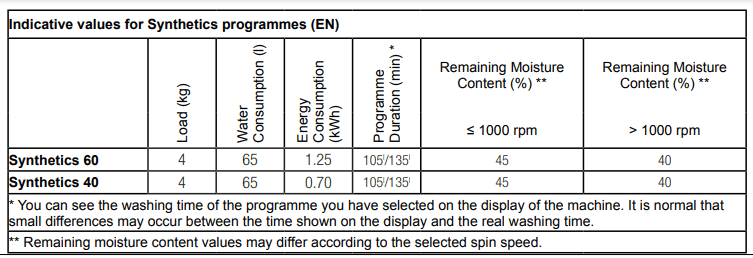
Programme and consumption table
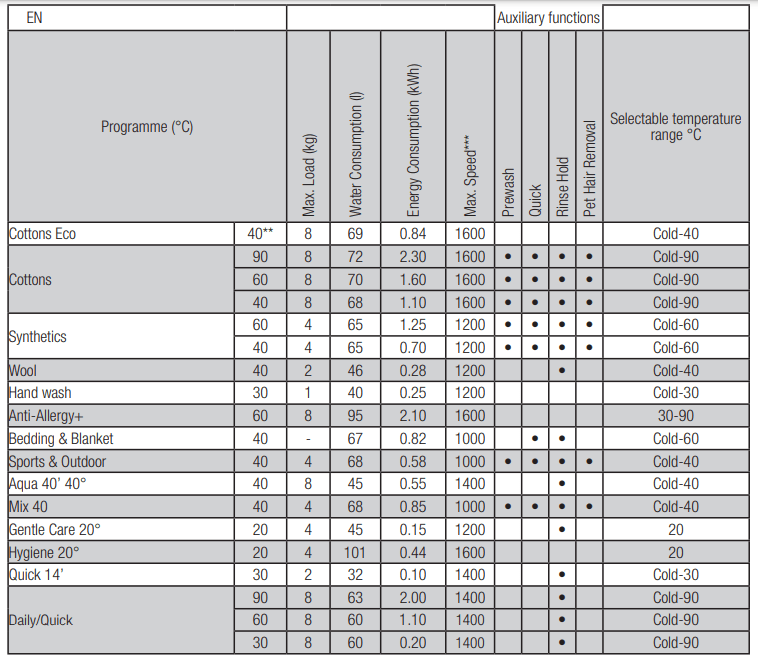
• : Selectable.
* : Automatically selected, no canceling.
** : Energy Label programme (AS/NZS 2040)
*** : If maximum spin speed of the machine is lower then this value, you can only select up to the maximum spin speed.
**** : Programme detects the type and quantity of the laundry to automatically adjust water and energy consumption and programme time.
- : See the programme description for maximum load.
The auxiliary functions in the table may vary according to the model of your machine.
Water and power consumption may vary subject to the changes in water pressure, water hardness and temperature, ambient temperature, type and amount of laundry, selection of auxiliary functions and spin speed, and changes in electric voltage.
You can see the washing time of the programme you have selected on the display of the machine. It is normal that small differences may occur between the time shown on the display and the real washing time.
“Selection patterns for auxiliary functions can be changed by the manufacturer company. New selection patterns can be added or removed.”
“The spin speed of your machine may vary according to the programme; this spin speed cannot exceed the max. spin speed of your machine.”
Auxiliary function selection
Select the desired auxiliary functions before starting the programme.
Whenever a programme is selected, if a relevant auxiliary function is selected its related indicator light will illuminate
Indicator lights of the auxiliary functions that are not allowed to be selected with the current programme will flash and an audio warning is given.
Furthermore, you may also select or cancel auxiliary functions that are suitable to the running programme after the washing cycle starts. If the wash cycle has reached a point where no auxiliary function can be selected, an audio warning will be given and the related auxiliary function's light will flash.
Some functions cannot be selected together. If a second auxiliary function conflicting with the first one is selected before starting the machine, the function selected first will be canceled and the second auxiliary function selection will remain active. For example, if you want to select Quick Wash after you have selected the Additional Water, Additional Water will be canceled and Quick Wash will remain active.
An auxiliary function that is not compatible with the programme cannot be selected. (See, “Programme and consumption table")
Some programmes have auxiliary functions that must be operated simultaneously. Those functions cannot be cancelled. The frame of the auxiliary function will not be illuminated, only inner area will be illuminated.
- Prewash
A Prewash is only worthwhile for heavily soiled laundry. Not using the Prewash will save energy, water, detergent and time.
- Quick
This function can be used in Cottons and Synthetics programmes. It decreases the washing times and also the number of rinsing steps for lightly soiled laundry
When you select this function, load your machine with half of the maximum laundry specified in the programme table.
- Rinse Hold
If you are not going to unload your clothes immediately after the programme completes, you can use rinse hold function to keep your laundry in the final rinsing water in order to prevent them from getting wrinkled when there is no water in the machine. Press Start / Pause button after this process if you want to drain the water without spinning your laundry. Programme will resume and complete after draining the water.
If you want to spin the laundry held in water, adjust the Spin Speed and press Start / Pause button.
The programme resumes. Water is drained, laundry is spun and the programme is completed.
- Pet hair removal
This function helps to remove pet hair that remain on your garments more effectively.
When you select this function, Prewash and Extra Rinse steps are added to the normal programme. Thus, washing is performed with more water (30%) and the pet hair is removed more effectively.
WARNING: Never wash your pets in the washing machine.
End Time
With the End Time function, the startup of the programme may be delayed up to 24 hours. After pressing End Time button, the programme's estimated ending time is displayed. If the End Time is adjusted, End Time indicator is illuminated.
In order for the End Time function to be activated and the programme to be completed at the end of the specified time, you must press Start / Pause button after adjusting the time.
If you want to cancel End Time function, press On / Off button to turn off and on the machine.
Do not use liquid detergents when you activate End Time function! There is the risk of staining of the clothes.
- Open the loading door, place the laundry and put detergent, etc.
- Select the washing programme, temperature, spin speed and, if required, the auxiliary functions.
- Set the end time of your choice by pressing the End Time button. End Time indicator illuminates.
- Press Start / Pause button. Time countdown starts. “:” sign in the middle of the end time on the display starts flashing.
Additional laundry may be loaded during the End Time countdown period. At the end of the countdown, End Time indicator turns off, washing cycle starts and the time of the selected programme appears on the display.
When the End Time selection is completed, the time appears on the screen consists of end time plus the duration of the selected programme.
Starting the programme
- Press Start / Pause button to start the programme.
- Programme follow-up light showing the startup of the programme will turn on.
If no programme is started or no key is pressed within 1-10 minute during programme selection process, the machine will switch to OFF mode. Display and all indicators are turned off.
Selected programme data will be displayed if you press On / Off button.
Loading door lock
There is a locking system on the loading door of the machine that prevents opening of the door in cases when the water level is unsuitable.
"Door Locked" LED in the panel turns on when the loading door is locked.
Changing the selections after the programme has started
After the programme has started you can make the following changes.
Switching the machine to pause mode:
Press the Start/Pause button to switch the machine to pause mode while a programme is running. The light indicating the Start/Pause status and programme step starts flashing on the Programme Follow-up indicator to show that the machine has been switched to the pause mode. Also, Loading Door light will also flash until the door is ready to be opened. When the loading door is ready to be opened loading door light will will turn off and programme step indicator and Start / Stop LED continue to flash.
Also, when the loading door is ready to be opened, Loading Door light will also turn off in addition to the programme step light.
Changing the auxiliary function, speed and temperature
Depending on the step the programme has reached, you can cancel or select the auxiliary functions. See, "Auxiliary function selection".
You can also change the speed and temperature settings. See, "Spin speed selection" and "Temperature selection".
If no change is allowed, the relevant light will flash for 3 times.
Adding or taking out laundry
1. Press the Start / Pause button to switch the machine to pause mode. The programme follow-up light of the relevant step during which the machine was switched into the pause mode will flash.
2. Wait until the Loading Door can be opened.
3. Open the Loading Door and add or take out the laundry.
5. Close the Loading Door.
6. Make changes in auxiliary functions, temperature and speed settings if necessary.
7. Press Start/Pause button to start the machine.
Child Lock
Use Child Lock function to prevent children from tampering with the machine. Thus you can avoid any changes in a running programme
You can switch on and off the machine with On / Off button when the Child Lock is active. When you switch on the machine again, programme will resume from where it has stopped.
To activate the child lock:
Press and hold Auxiliary Function button 2 for 3 seconds. In the programme selection display on the panel, "Child lock enabled" light will turn on. You can release Auxiliary Function button 2 when this warning is displayed.
To deactivate the child lock:
Press and hold Auxiliary Function button 2 for 3 seconds. In the programme selection display on the panel, "Child lock enabled" light will turn off.
Canceling the programme
The programme is cancelled when the machine is turned off and on again. Press and hold On / Off button for 3 seconds.
If you press On / Off button when the Child Lock is enabled, the programme will not be cancelled. You should cancel the Child Lock first.
If you want to open the loading door after you have cancelled the programme but it is not possible to open the loading door since the water level in the machine is above the loading door opening, then turn the Programme Selection knob to Pump + Spin programme and discharge the water in the machine.
End of programme
End LED appears on the display when the programme is completed.
If you do not press any button for 10 minutes, the machine will switch to OFF mode. Display and all indicators are turned off.
Completed programme steps will be displayed if you press On / Off button.
Your machine features "Standby Mode".
After you switch on your machine with On-Off button, if no program is started or no other procedure is performed at the selection step or no action is taken within approx. 10 minutes after the selected program ends, your machine will switch to OFF mode automatically. Display and all indicators are turned off. Selected programme data will be displayed if you press On / Off button. Before you start the program, check the accuracy of your selections. If necessary, repeat them. This is not an error.
Maintenance and cleaning
Service life of product extends and frequently experienced problems will be reduced if it is cleaned at regular intervals.
Cleaning the detergent drawer
Clean the detergent drawer at regular intervals (every 4-5 washing cycles) as shown below in order to prevent accumulation of powder detergent in time.
Lift the rear part of the siphon to remove it as illustrated.
If more than normal amount of water and softener mixture starts to gather in the softener compartment, the siphon must be cleaned.
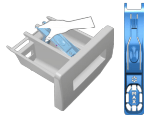
- Press the dotted point on the siphon in the softener compartment and pull towards you until the compartment is removed from the machine.
- Wash the detergent drawer and the siphon with plenty of lukewarm water in a washbasin. In order to prevent the residues to contact your skin, clean it with an appropriate brush by wearing a pair of gloves.
- Insert the drawer back into its place after cleaning and make sure that it is seated well.
Cleaning the loading door and the drum
For products with drum cleaning programme, please see Operating the product - Programmes.
For products without drum cleaning, follow the below steps to clean the drum:
Select Additional Water or Extra Rinse auxiliary functions. Use a Cottons programme without pre-wash.
Set the temperature to the level recommended on the drum cleaning agent which can be provided from authorized services. Apply this procedure without any laundry in the product. Before starting the programme, put 1 pouch of special drum cleaning agent (if the special agent could not be supplied, put max. 100 g of powder anti-limescale) into the main wash detergent compartment (compartment no. „2“). If the antilimescale is in tablet form, put only one tablet into the main wash compartment no. „2“. Dry the inside of the bellow with a clean piece of cloth after the programme has come to an end.
Repeat Drum Cleaning process in every 2 months.
Use an anti-limescale suitable for the washing machines.
After every washing make sure that no foreign substance is left in the drum.
If the holes on the bellow shown in the figure is blocked, open the holes using a toothpick.
Foreign metal substances will cause rust stains in the drum. Clean the stains on the drum surface by using cleaning agents for stainless steel.
Never use steel wool or wire wool. These will damage the painted, chromated and plastic surfaces.

Cleaning the body and control panel
Wipe the body of the machine with soapy water or non-corrosive mild gel detergents as necessary, and dry with a soft cloth.
Use only a soft and damp cloth to clean the control panel.
Cleaning the water intake filters
There is a filter at the end of each water intake valve at the rear of the machine and also at the end of each water intake hose where they are connected to the tap. These filters prevent foreign substances and dirt in the water to enter the washing machine. Filters should be cleaned as they do get dirty
- Close the taps.
- Remove the nuts of the water intake hoses to access the filters on the water intake valves. Clean them with an appropriate brush. If the filters are too dirty, remove them from their places with a pliers and clean in this way.
- Take out the filters on the flat ends of the water intake hoses together with the gaskets and clean thoroughly under running water.
- Replace the seals and filters carefully and tighten their nuts by hand.

Draining remaining water and cleaning the pump filter
The filter system in your machine prevents solid items such as buttons, coins and fabric fibers clogging the pump impeller during discharge of washing water. Thus, the water will be discharged without any problem and the service life of the pump will extend.
If the machine fails to drain water, the pump filter is clogged. Filter must be cleaned whenever it is clogged or in every 3 months. Water must be drained off first to clean the pump filter.
In addition, prior to transporting the machine (e.g., when moving to another house) and in case of freezing of the water, water may have to be drained completely.
CAUTION: Foreign substances left in the pump filter may damage your machine or may cause noise problem.
CAUTION: If the product is not being used, shut the tap shut, remove mains pipe and drain the water inside the machine against any likely freezing.
CAUTION: After each use, turn off the water tap to which the mains hose is connected.
In order to clean the dirty filter and discharge the water:
1. Unplug the machine to cut off the supply power.
CAUTION: Temperature of the water inside the machine may rise up to 90 ºC. To avoid the burning risk, clean the filter after the water inside the machine is cooled down.
2. Open the filter cover

3. Follow the below procedures in order to drain water.
The product has an emergency water draining hose, in order to drain the water:
a. Pull the emergency draining hose out from its seat
b. Place a large container at the end of the hose. Drain the water into the container by pulling out the plug at the end of the hose. When the container is full, block the inlet of the hose by replacing the plug. After the container is emptied, repeat the above procedure to drain the water in the machine completely.
c. When draining of water is finished, close the end by the plug again and fix the hose in its place.
d. Turn and remove the pump filter.

4. Clean any residues inside the filter as well as fibers, if any, around the pump impeller region.
5. Replace the filter.
6. If the filter cap is composed of two pieces, close the filter cap by pressing on the tab. If it is one piece, seat the tabs in the lower part into their places first, and then press the upper part to close.
Troubleshooting
| Problem | Reason | Solution |
| Program does not start after closing the door. | Start / Pause / Cancel button was not pressed. | Press the Start / Pause / Cancel button. |
| Programme cannot be started or selected. | Washing machine has switched to self protection mode due to a supply problem (line voltage, water pressure, etc.). | Press and hold On / Off button for 3 seconds. (see. "Cancellation of program") |
| Water in the machine. | Some water might have remained in the product due to the quality control processes in the production. | This is not a failure; water is not harmful to the machine. |
| Machine does not fill with water. | Tap is turned off. | Turn on the taps. |
| Water inlet hose is bent. | Flatten the hose. | |
| Water inlet filter is clogged. | Clean the filter | |
| Loading door may be open | Close the door | |
| Machine does not drain water. | Water drain hose might be clogged or twisted. | Clean or flatten the hose. |
| Pump filter is clogged | Clean the pump filter. | |
| Machine vibrates or makes noise | Machine might be standing unbalanced | Adjust the feet to level the machine |
| A hard substance might have entered into the pump filter | Clean the pump filter. | |
| Transportation safety bolts are not removed | Remove the transportation safety bolts. | |
| Laundry quantity in the machine might be too little | Add more laundry to the machine. | |
| Machine might be overloaded with laundry. | Take out some of the laundry from the machine or distribute the load by hand to balance it homogenously in the machine | |
| Machine might be leaning on a rigid item. | Make sure that the machine is not leaning on anything. | |
| There is water leaking from the bottom of the washing machine | Water drain hose might be clogged or twisted. | Clean or flatten the hose. |
| Pump filter is clogged. | Clean the pump filter. | |
| Machine stopped shortly after the programme started. | Machine might have stopped temporarily due to low voltage. | It will resume running when the voltage restores to the normal level. |
| Machine directly discharges the water it takes in. | Draining hose might not be at adequate height. | Connect the water draining hose as described in the operation manual. |
| No water can be seen in the machine during washing | The water level is not visible from outside of the washing machine. | This is not a failure |
| Loading door cannot be opened. | Door lock is activated because of the water level in the machine. | Drain the water by running the Pump or Spin programme. |
| Machine is heating up the water or it is at the spinning cycle. | Wait until the programme completes | |
| Child lock is engaged. Door lock will be deactivated a couple of minutes after the programme has come to an end. | Wait for a couple of minutes for deactivation of the door lock. | |
| Washing takes longer time than specified in the manual.(*) | Water pressure is low. | Machine waits until taking in adequate amount of water to prevent poor washing quality due to the decreased amount of water. Therefore, the washing time extends. |
| Voltage might be low. | Washing time is prolonged to avoid poor washing results when the supply voltage is low. | |
| Input temperature of water might be low. | Required time to heat up the water extends in cold seasons. Also, washing time can be lengthened to avoid poor washing results. | |
| Number of rinses and/or amount of rinse water might have increased. | Machine increases the amount of rinse water when good rinsing is needed and adds an extra rinsing step if necessary | |
| Excessive foam might have occurred and automatic foam absorption system might have been activated due to too much detergent usage. | Use recommended amount of detergent. | |
| Programme time does not countdown. (On models with display) (*) | Timer may stop during water intake. | Timer indicator will not countdown until the machine takes in adequate amount of water. The machine will wait until there is sufficient amount of water to avoid poor washing results due to lack of water. Timer indicator will resume countdown after this. |
| Timer may stop during heating step. | Timer indicator will not countdown until the machine reaches the selected temperature | |
| Timer may stop during spinning step. | Automatic unbalanced load detection system might be activated due to the unbalanced distribution of the laundry in the drum | |
| Programme time does not countdown. (*) | There might be unbalanced load in the machine. | Automatic unbalanced load detection system might be activated due to the unbalanced distribution of the laundry in the drum. |
| Machine does not switch to spinning step. (*) | There might be unbalanced load in the machine. | Automatic unbalanced load detection system might be activated due to the unbalanced distribution of the laundry in the drum. |
| The machine will not spin if water is not drained completely. | Check the filter and the draining hose. | |
| Excessive foam might have occurred and automatic foam absorption system might have been activated due to too much detergent usage. | Use recommended amount of detergent. | |
| Washing performance is poor: Laundry turns gray. (**) | Insufficient amount of detergent has been used over a long period of time. | Use the recommended amount of detergent appropriate for water hardness and the laundry. |
| Washing was made at low temperatures for a long time | Select the proper temperature for the laundry to be washed. | |
| Insufficient amount of detergent is used with hard water | Using insufficient amount of detergent with hard water causes the soil to stick on the cloth and this turns the cloth into gray in time. It is difficult to eliminate graying once it happens. Use the recommended amount of detergent appropriate for water hardness and the laundry. | |
| Too much detergent is used | Use the recommended amount of detergent appropriate for water hardness and the laundry | |
| Washing performance is poor: Stains persist or the laundry is not whitened. (**) | Insufficient amount of detergent is used | Use the recommended amount of detergent appropriate for water hardness and the laundry |
| Excessive laundry was loaded in | Do not load the machine in excess. Load with amounts recommended in the "Programme and consumption table". | |
| Wrong programme and temperature were selected. | Select the proper programme and temperature for the laundry to be washed. | |
| Wrong type of detergent is used. | Use original detergent appropriate for the machine. | |
| Too much detergent is used. | Put the detergent in the correct compartment. Do not mix the bleaching agent and the detergent with each other. | |
| Washing performance is poor: Oily stains appeared on the laundry. (** | Regular drum cleaning is not applied | Clean the drum regularly. For this, please see 4.4.2. |
| Washing performance is poor: Clothes smell unpleasantly. (**) | Odours and bacteria layers are formed on the drum as a result of continuous washing at lower temperatures and/or in short programmes. | Leave the detergent drawer as well as the loading door of the machine ajar after each washing. Thus, a humid environment favorable for bacteria cannot occur in the machine. |
| Colour of the clothes faded. (**) | Excessive laundry was loaded in | Do not load the machine in excess |
| Detergent in use is damp. | Keep detergents closed in an environment free of humidity and do not expose them to excessive temperatures. | |
| A higher temperature is selected. | Select the proper programme and temperature according to the type and soiling degree of the laundry | |
| It does not rinse well. | The amount, brand and storage conditions of the detergent used are inappropriate. | Use a detergent appropriate for the washing machine and your laundry. Keep detergents closed in an environment free of humidity and do not expose them to excessive temperatures |
| Detergent is put in the wrong compartment. | If detergent is put in the prewash compartment although prewash cycle is not selected, machine can take this detergent during rinsing or softener step. Put the detergent in the correct compartment. | |
| Pump filter is clogged. | Check the filter | |
| Drain hose is folded. | Check the drain hose. | |
| Laundry became stiff after washing. (**) | Insufficient amount of detergent is used. | Using insufficient amount of detergent for the water hardness can cause the laundry to become stiff in time. Use appropriate amount of detergent according to the water hardness. |
| Detergent is put in the wrong compartment. | If detergent is put in the prewash compartment although prewash cycle is not selected, machine can take this detergent during rinsing or softener step. Put the detergent in the correct compartment. | |
| Detergent might be mixed with the softener | Do not mix the softener with detergent. Wash and clean the dispenser with hot water. | |
| Laundry does not smell like the softener. (**) | Detergent is put in the wrong compartment. | If detergent is put in the prewash compartment although prewash cycle is not selected, machine can take this detergent during rinsing or softener step. Wash and clean the dispenser with hot water. Put the detergent in the correct compartment. |
| Detergent might be mixed with the softener | Do not mix the softener with detergent. Wash and clean the dispenser with hot water. | |
| Detergent residue in the detergent drawer. (**) | Detergent is put in wet drawer. | Dry the detergent drawer before putting in detergent. |
| Detergent has gotten damp | Keep detergents closed in an environment free of humidity and do not expose them to excessive temperatures | |
| Water pressure is low. | Check the water pressure | |
| The detergent in the main wash compartment got wet while taking in the prewash water. Holes of the detergent compartment are blocked | Check the holes and clean if they are clogged. | |
| There is a problem with the detergent drawer valves. | Call the Authorized Service Agent. | |
| Detergent might be mixed with the softener. | Do not mix the softener with detergent. Wash and clean the dispenser with hot water | |
| Regular drum cleaning is not applied. | Clean the drum regularly. For this, please see 4.4.2. | |
| Too much foam forms in the machine. (**) | Improper detergents for the washing machine are being used. | Use detergents appropriate for the washing machine |
| Excessive amount of detergent is used. | Use only sufficient amount of detergent. | |
| Detergent was stored under improper conditions. | Store detergent in a closed and dry location. Do not store in excessively hot places | |
| Some meshed laundry such as tulle may foam too much because of their texture. | Use smaller amounts of detergent for this type of item. | |
| Detergent is put in the wrong compartment. | Put the detergent in the correct compartment | |
| Softener is being taken early | There may be problem in the valves or in the detergent dispenser. Call the Authorized Service Agent. | |
| Foam is overflowing from the detergent drawer. | Too much detergent is used. | Mix 1 tablespoonful softener and ½ l water and pour into the main wash compartment of the detergent drawer |
| Put detergent into the machine suitable for the programmes and maximum loads indicated in the “Programme and consumption table”. When you use additional chemicals (stain removers, bleachs and etc), reduce the amount of detergent. | ||
| Laundry remains wet at the end of the programme. (*) | Excessive foam might have occurred and automatic foam absorption system might have been activated due to too much detergent usage. | Use recommended amount of detergent. |
| (*) Machine does not switch to spinning step when the laundry is not evenly distributed in the drum to prevent any damage to the machine and to its surrounding environment. Laundry should be rearranged and re-spun. | ||
| (**) Regular drum cleaning is not applied. Clean the drum regularly. See 4.4.2 | ||
CAUTION: If you cannot eliminate the problem although you follow the instructions in this section, consult your dealer or the Authorized Service Agent. Never try to repair a nonfunctional product yourself.
See other models: BFC916GMX DFN38450W CWB6403X HII63500FHT BVF290W
